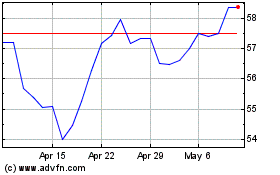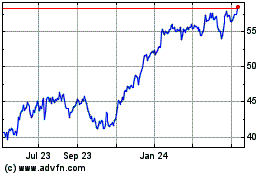By Ryan Tracy and Emily Glazer
WASHINGTON -- U.S. regulators slapped embattled Wells Fargo
& Co. with new sanctions Tuesday, concluding the bank had
failed to devise an adequate blueprint for avoiding a taxpayer
bailout if it were on the brink of bankruptcy.
The rebuke over the bank's so-called "living will" submission
surprised executives and was another black eye for a bank that is
still reeling from a scandal over its creation of bogus customer
accounts. Even more stinging: the news was akin to failing a
make-up test as the San Francisco bank had failed an initial test
in April.
The bank's executives raced to figure out what went wrong and
immediately began "doing a post-mortem," a person familiar with the
matter said. In response to the announcement - and the amount of
detail released by regulators - the bank on Tuesday also released
more detail about work it has done since resubmitting its living
will, this person said.
This is the first time the Federal Reserve and Federal Deposit
Insurance Corp. have imposed penalties on a bank under the
living-wills process created by the 2010 Dodd-Frank
financial-overhaul law. As a result, Wells Fargo is now barred from
creating new international banking units or acquiring any nonbank
subsidiaries. If regulators aren't happy with the bank's response
to Tuesday's findings to be submitted by March 2017, they could cap
growth at the bank and, in two years, force it to divest itself of
certain assets under Dodd-Frank.
Wells Fargo was alone in being flunked by regulators. Four
others who also failed in the first round, including J.P. Morgan
Chase & Co. and Bank of America Corp., were found Tuesday to
have corrected the problems regulators had identified.
Wells Fargo now faces a new challenge from Washington even as it
remains under investigation by numerous federal and state agencies,
including the Justice Department: to show it can live up to its
obligation, imposed after the financial crisis, to create a plan
for how it would go through bankruptcy during a period of severe
distress without tapping into public funds, the way some big banks
did in 2008.
The living-wills process is a pillar of the new financial
regulatory regime enacted under President Barack Obama. Many banks
have complained that regulators have applied the rules too
stringently, and President-elect Donald Trump has vowed to ease up
on postcrisis regulations. While he can't immediately change the
leadership at the Fed and FDIC, he can quickly fill a longstanding
vacancy for the Fed's top banking overseer, who will have
significant sway over how living wills are enforced going
forward.
Wells Fargo said in a statement that it took its feedback from
its 2015 living-wills submission "very seriously and took several
steps to address it." The bank said that while it is disappointed
by the regulators' decision, it will work cely with the agencies to
better understand their concerns.
In a memo to employees Tuesday reviewed by The Wall Street
Journal, Wells Fargo Chief Executive Timothy Sloan wrote that the
bank will continue to work closely with regulators "to better
understand their concerns," but added that "living wills are a form
of contingency planning. They are not a scorecard for the current
health of Wells Fargo or any bank."
The regulators could have, but didn't, impose higher capital
requirements on the firm, a potentially stricter sanction.
Wells Fargo has been under fire since its sales-tactics scandal
exploded into public view in September. The firm, once a golden
child among big banks, paid a $185 million fine to a separate set
of federal regulators, along with a the Los Angeles City Attorney's
office, over opening as many as 2.1 million accounts with
unauthorized or fictitious customer information.
Since then, Wells Fargo has faced withering public and political
criticism. Former Chief Executive John Stumpf retired abruptly
after being grilled in two congressional hearings. The Office of
the Comptroller of the Currency last month imposed further
restrictions on the bank's operations over that controversy and is
looking at still further restrictions on the bank's ability to
expand.
As part of its efforts to mend relations with regulators, Mr.
Sloan, who took over in October, has been traveling regularly to
Washington. But Mr. Sloan has said in meetings with bank executives
and employees over the past several weeks that matters will get
worse before they get better, according to people who attended the
meetings and recordings reviewed by The Wall Street Journal. Mr.
Sloan has also said that the bank should expect tough times from
regulators across the firm, not just its retail-banking unit.
The new sanctions issued Tuesday opened a whole new front of
questions from regulators about the institution's management,
related to whether they are properly structured, in the eyes of
regulators, to respond to a new financial crisis.
Tuesday's verdict came after months of regular meetings between
regulatory staff and the five firms to discuss aspects of the
living wills, from banks' derivatives businesses to their legal
structures. Along with J.P. Morgan and Bank of America, Bank of New
York Mellon Corp. and State Street Corp. were told they had
addressed regulators' concerns.
In a letter Tuesday to Wells Fargo, the Fed and FDIC hit Wells
Fargo with blunt criticism. They said the firm "has not even
completed an assessment" related to how it would keep operating
critical services during a bankruptcy, for example.
Earlier this year, Wells Fargo was the only bank that was
flunked for "material errors" in its living-wills submission.
Regulators said Tuesday that the firm had addressed governance
issues in the living will.
Verdicts on the living wills are closely watched on Capitol
Hill, where advocates of breaking up megabanks have pushed
regulators to aggressively use this part of Dodd-Frank to pressure
them to shrink or reduce risk.
Tuesday's decision didn't directly address whether the big banks
remain "too big to fail." In April, the five big banks, along with
Goldman Sachs Group Inc., Morgan Stanley and Citigroup Inc., were
given a list of separate regulatory concerns that were required to
be addressed by July 2017, when all the firms must submit new
living wills. That will pose another test for each of the banks,
and it is possible that regulators could impose additional
sanctions on some firms if they don't make enough progress by
July.
Write to Ryan Tracy at ryan.tracy@wsj.com and Emily Glazer at
emily.glazer@wsj.com
(END) Dow Jones Newswires
December 14, 2016 02:47 ET (07:47 GMT)
Copyright (c) 2016 Dow Jones & Company, Inc.
Bank of New York Mellon (NYSE:BK)
Historical Stock Chart
From Mar 2024 to Apr 2024

Bank of New York Mellon (NYSE:BK)
Historical Stock Chart
From Apr 2023 to Apr 2024
